Welcome to Corpus Christi Catholic Church, Rejoice, and Come In!

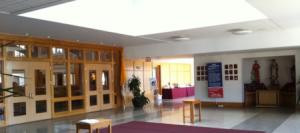
Narthex
The narthex is a large gathering space that serves as a place of welcome for worshippers and provides the transition between the outside environment and the place for prayer. In the early church, this gathering space served as a “waiting room” for penitents and for those preparing for baptism (catechumens). Today, it is the space where ushers and greeters mirror the hospitality of Christ to parish members and visitors.
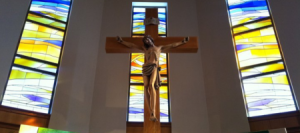
Corpus Christi, Body of Christ
Corpus Christi Parish is comprised of more than 3,800 families. We are the Body of Christ.
Crucifix
The crucifix is the most solemn and significant symbol of the Christian faith and represents the absolute sacrifice made by Christ for our salvation. Catholics begin every act of worship with the sign of the cross, and the cross always has a prominent and central place within the church building.
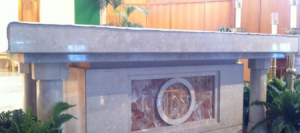
Altar
The altar is the table on which the Eucharist is celebrated. It is called the altar of sacrifice because Catholics remember Christ’s own sacrifice on the cross.

Ambo
While the altar is the center of the second part of the Mass, the Liturgy of the Eucharist, the ambo (sometimes called the pulpit) is the center for the first part of the Mass, the Liturgy of the Word. The ambo is frequently called the table of God’s Word because it is the place from which the Word of God nourishes the faithful.
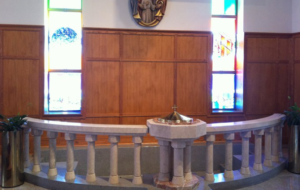
Baptismal Font
The baptismal font is located in the front of our church to the right of the altar and ambo to manifest the central importance of baptism and its relationship to the whole Eucharistic community. In the waters of baptism, the Church becomes the joyful mother of many children who will grow as disciples of Christ.
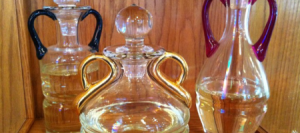
Holy Oils
The holy oils are blessed by the bishop at the Holy Thursday Chrism Mass at the Cathedral Basilica of Saints Peter and Paul and then distributed to all the parishes in the Philadelphia Archdiocese. The ambry contains the oil of catechumens for anointing those who are preparing for baptism, the oil of chrism for the sacraments of baptism and confirmation, and the oil of the sick for the sacrament of anointing of the sick. Catholic Christians are anointed at various points of their lives with oils, showing that they are a prophetic, priestly, and kingly people in the pattern of Jesus Christ.
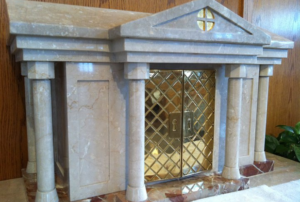
Tabernacle
The word tabernaclederives from the Latin and means “a tent.” It is the receptacle in which the consecrated Hosts for Holy Communion are reserved in churches and chapels.
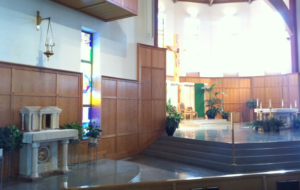
Sanctuary Lamp
Early in the church’s life, it became necessary to reserve some portion of the Eucharist so that those who were ill, or in prison for their faith, could also share in the family meal of Christians. A tabernacle/sanctuary lamp is kept nearby to call attention to the real presence of Jesus in the Blessed Sacrament.
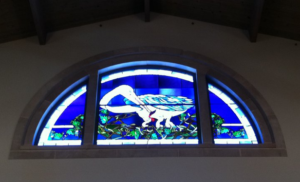
The Pelican
The pelican, featured in this stained glass window, is a symbol of the Eucharist and Christ’s Passion. It reflects the legend that a pelican sacrifices its own blood to nourish its young.
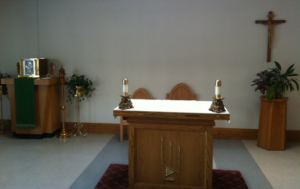
Chapel
The chapel is located in the interior of our church and to its left. Weekday Masses are celebrated in our chapel at 7:15 AM. Saturday morning Mass is at 7:15 AM followed by a Novena to the Miraculous Medal.

Reconciliation Rooms
The reconciliation rooms, located in our chapel, provide the option of either face-to-face confession or anonymous confession behind a screen. The Sacrament of Reconciliation is celebrated every Saturday following the 7:15 AM Mass and from 3:15 PM to 4:00 PM.

Sacristy
The sacristy or vesting area is a small room where the sacred vessels and liturgical vestments are kept. It serves as a place where the priests and deacons can prayerfully prepare for the liturgy and transition into worship.

Saint Frances Xavier Cabrini
Saint Frances Xavier Cabrini was born in Italy in 1850. Mother Cabrini is the founder of the Missionary Sisters of the Sacred Heart. She and her missionaries instituted schools, hospitals, and orphanages in America to aid Italian immigrants and children. Because of her endeavors, she is considered the patron saint of immigrants, hospital administrators, and orphans. Mother Cabrini was declared a saint in 1946 by Pope Pius XII and is the first American citizen ever to be canonized.
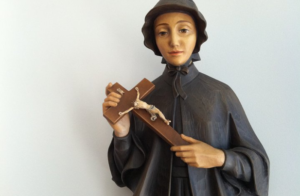
Saint Elizabeth Ann Seton
Saint Elizabeth Ann Seton was a wife and mother of five children.After the death of her husband, she converted to Catholicism and opened the first Catholic free school in America. She was declared a saint in 1975 by Pope Paul VI and is the first native born American ever to be canonized. Elizabeth Ann Seton is the patron saint of widows.
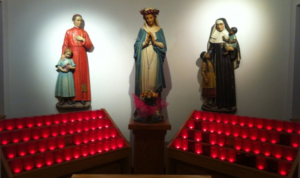
Mary, our Mother, Saint John Neumann & Saint Katharine Drexel
“United with Mary, our Mother, with Saint Joseph, her husband, and with Saint John Neumann and Saint Katharine Drexel, our own patron saints, we give joyful praise to God for his countless blessings. Together let us renew our commitment to answer the call to follow our Lord Jesus Christ in hope, as we faithfully strive to fulfill our share in his mission, generously responding to his call to conversion and holiness.”
Excerpted from the Pastoral Letter of Cardinal Justin Rigali, Archbishop of Philadelphia.
